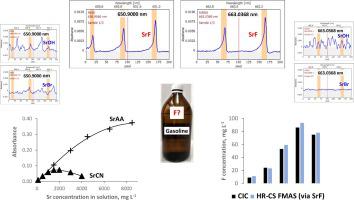Our official English website, www.x-mol.net, welcomes your
feedback! (Note: you will need to create a separate account there.)
Strontium monofluoride – a new molecule to measure fluorine using high-resolution continuum source flame molecular absorption spectrometry and its application for gasoline analysis
Fuel ( IF 6.7 ) Pub Date : 2023-08-25 , DOI: 10.1016/j.fuel.2023.129501 Zofia Kowalewska
Fuel ( IF 6.7 ) Pub Date : 2023-08-25 , DOI: 10.1016/j.fuel.2023.129501 Zofia Kowalewska

|
In this work, for the first time, strontium monofluoride was generated in an air-acetylene flame of a high-resolution continuum source molecular absorption spectrometer with the aim of fluorine determination via molecular absorption. The particular task was the determination of organic fluorine in gasoline/its components dissolved in xylene. Sequential measurements in the area of the most intensive absorption of the molecule were executed to select the spectral range for analysis. The acquired spectra differed from the ones from the literature, especially the emission spectra. The best and comparable sensitivity has been registered near 651 nm and 663 nm in measurements of rotations from the range of the XΣ → AΠ electronic transition of the SrF molecule. Unfortunately, SrOH molecules were also spontaneously formed and absorbed radiation in the selected area. No other spectral interferences were found, except absorption by the SrBr molecule, which could have been formed in the flame despite a relatively low energy bond of 330 kJ/mol. The dependence of generation of the SrF and the SrOH molecules on the flame conditions was studied for pure solvent (xylene) and solutions of investigated samples of gasoline type. The effect of the SrOH molecule was overcome by blank subtraction or the least square background correction. The last method had to be used to overcome the SrBr effect. Due to the various combustion properties of various hydrocarbons and their different behaviour in flame, applying the simplified standard addition method became indispensable. As a source of strontium, an oil Sr standards or Sr acetylacetonate (SrAA) were investigated. The crucial benefit of SrF molecule application was the relatively good solubility (and relatively low price) of SrAA. Under the selected conditions, the characteristic concentration of fluorine was 1.9 and 2.0 mg/L, while the instrumental detection limit was 0.5 and 0.8 mg/L for the 651 and 663 nm ranges, respectively. The analytical technique enables the analysis of samples diluted to a small degree, e.g. 1:3 v:v and the best method detection limit is 1.3 mg/L. The proposed method is fast and cheap.
中文翻译:

一氟化锶——一种利用高分辨率连续源火焰分子吸收光谱法测量氟的新分子及其在汽油分析中的应用
本工作首次在高分辨率连续源分子吸收光谱仪的空气-乙炔火焰中产生一氟化锶,旨在通过分子吸收测定氟。具体任务是测定汽油中的有机氟/溶解在二甲苯中的其组分。在分子吸收最强烈的区域进行连续测量,以选择分析的光谱范围。获得的光谱与文献中的光谱不同,尤其是发射光谱。在测量 SrF 分子 XΣ → AΠ 电子跃迁范围内的旋转时,在 651 nm 和 663 nm 附近获得了最佳且可比的灵敏度。不幸的是,SrOH 分子也在选定区域自发形成并吸收辐射。除了 SrBr 分子的吸收外,没有发现其他光谱干扰,尽管 SrBr 分子的能量键相对较低,为 330 kJ/mol,但 SrBr 分子可能在火焰中形成。针对纯溶剂(二甲苯)和汽油类型研究样品的溶液,研究了 SrF 和 SrOH 分子的生成对火焰条件的依赖性。通过空白扣除或最小二乘背景校正克服了 SrOH 分子的影响。必须使用最后一种方法来克服 SrBr 效应。由于各种碳氢化合物的燃烧特性不同,在火焰中的行为也不同,因此采用简化的标准添加法就变得必不可少。作为锶源,对油 Sr 标准品或乙酰丙酮酸锶 (SrAA) 进行了研究。 SrF分子应用的关键好处是SrAA相对良好的溶解度(和相对较低的价格)。 在所选条件下,氟的特征浓度为1.9和2.0 mg/L,而仪器检测限在651和663 nm范围内分别为0.5和0.8 mg/L。该分析技术能够对小程度稀释的样品进行分析,例如1:3 v:v,最佳方法检测限为1.3 mg/L。所提出的方法快速且廉价。
更新日期:2023-08-25
中文翻译:

一氟化锶——一种利用高分辨率连续源火焰分子吸收光谱法测量氟的新分子及其在汽油分析中的应用
本工作首次在高分辨率连续源分子吸收光谱仪的空气-乙炔火焰中产生一氟化锶,旨在通过分子吸收测定氟。具体任务是测定汽油中的有机氟/溶解在二甲苯中的其组分。在分子吸收最强烈的区域进行连续测量,以选择分析的光谱范围。获得的光谱与文献中的光谱不同,尤其是发射光谱。在测量 SrF 分子 XΣ → AΠ 电子跃迁范围内的旋转时,在 651 nm 和 663 nm 附近获得了最佳且可比的灵敏度。不幸的是,SrOH 分子也在选定区域自发形成并吸收辐射。除了 SrBr 分子的吸收外,没有发现其他光谱干扰,尽管 SrBr 分子的能量键相对较低,为 330 kJ/mol,但 SrBr 分子可能在火焰中形成。针对纯溶剂(二甲苯)和汽油类型研究样品的溶液,研究了 SrF 和 SrOH 分子的生成对火焰条件的依赖性。通过空白扣除或最小二乘背景校正克服了 SrOH 分子的影响。必须使用最后一种方法来克服 SrBr 效应。由于各种碳氢化合物的燃烧特性不同,在火焰中的行为也不同,因此采用简化的标准添加法就变得必不可少。作为锶源,对油 Sr 标准品或乙酰丙酮酸锶 (SrAA) 进行了研究。 SrF分子应用的关键好处是SrAA相对良好的溶解度(和相对较低的价格)。 在所选条件下,氟的特征浓度为1.9和2.0 mg/L,而仪器检测限在651和663 nm范围内分别为0.5和0.8 mg/L。该分析技术能够对小程度稀释的样品进行分析,例如1:3 v:v,最佳方法检测限为1.3 mg/L。所提出的方法快速且廉价。





























 京公网安备 11010802027423号
京公网安备 11010802027423号